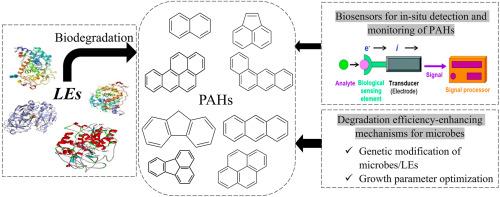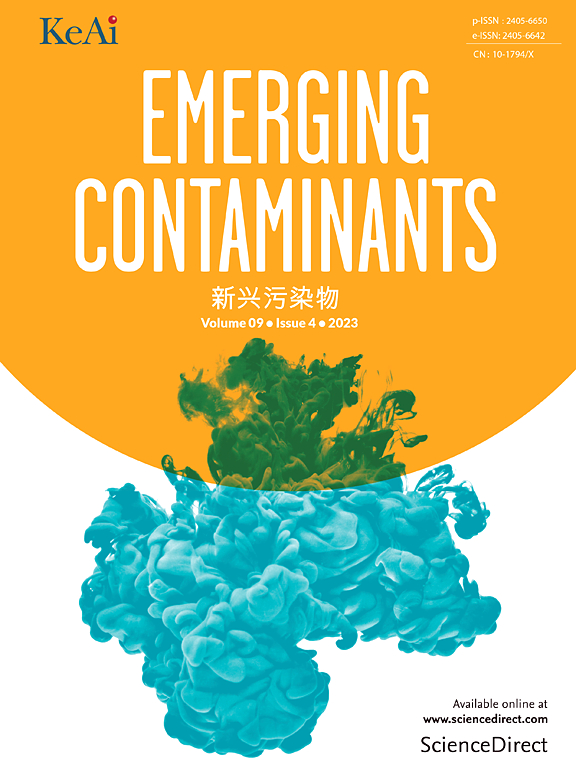Biodegradation of polycyclic aromatic hydrocarbons: The role of ligninolytic enzymes and advances of biosensors for in-situ monitoring
IF 5.3
2区 环境科学与生态学
Q1 ENVIRONMENTAL SCIENCES
引用次数: 0
Abstract
Polycyclic aromatic hydrocarbons (PAHs) and their derivatives are common pollutants that require effective remediation techniques. PAH biodegradation using bacterial and fungal enzymes has gained popularity because it effectively removes these contaminants. Ligninolytic enzymes (LEs), such as laccase (Lac), lignin peroxidase (LiP), manganese peroxidase (MnP), and versatile peroxidases (VPs), have been studied for their role in PAHs biodegradation. These enzymes, produced by different living organisms, have demonstrated significant potential in degrading complex PAH structures, contributing to cleaner and more sustainable remediation techniques. This review evaluates the biodegradation capacity of PAHs using different strains and/or their LEs and provides an in-depth analysis of their mechanisms and removal efficiencies. In addition, the fundamental catalytic mechanisms governing the biodegradation of PAHs and factors that must be optimized to promote effective breakdown and detoxification are highlighted. This review also highlights recent biosensor developments that provide enhanced sensitivity and specificity for PAH detection. Although some LE-producing strains are efficient in completely biodegrading certain PAH types, further research is needed to explore the complete biodegradation of PAHs with higher molecular structures using genetically modified strains or their LEs. Despite progress, challenges remain in optimizing enzyme activity and integrating biosensors into large-scale use. Future research should focus on enhancing stability and improving field deployment for better environmental monitoring.

多环芳烃的生物降解:木质素分解酶的作用和用于现场监测的生物传感器的进步
多环芳烃(PAHs)及其衍生物是常见的污染物,需要有效的修复技术。使用细菌和真菌酶进行多环芳烃生物降解能有效去除这些污染物,因此受到了广泛欢迎。人们研究了木质素分解酶(LEs),如漆酶 (Lac)、木质素过氧化物酶 (LiP)、锰过氧化物酶 (MnP) 和多功能过氧化物酶 (VPs),以了解它们在多环芳烃生物降解中的作用。这些由不同生物体产生的酶在降解结构复杂的多环芳烃方面具有巨大潜力,有助于采用更清洁、更可持续的修复技术。本综述评估了利用不同菌株和/或其 LEs 对 PAHs 进行生物降解的能力,并对其机理和去除效率进行了深入分析。此外,还重点介绍了多环芳烃生物降解的基本催化机制,以及为促进有效分解和解毒而必须优化的因素。本综述还重点介绍了最近开发的生物传感器,这些传感器可提高多环芳烃检测的灵敏度和特异性。尽管一些产生低浓有机溶剂的菌株能有效地完全生物降解某些类型的多环芳烃,但仍需进一步研究,利用转基因菌株或其低浓有机溶剂来探索具有更高分子结构的多环芳烃的完全生物降解。尽管取得了进展,但在优化酶活性和大规模使用生物传感器方面仍存在挑战。未来的研究应侧重于提高稳定性和改进现场部署,以更好地进行环境监测。
本文章由计算机程序翻译,如有差异,请以英文原文为准。
求助全文
约1分钟内获得全文
求助全文
来源期刊

Emerging Contaminants
Medicine-Public Health, Environmental and Occupational Health
CiteScore
10.00
自引率
6.70%
发文量
35
审稿时长
44 days
期刊介绍:
Emerging Contaminants is an outlet for world-leading research addressing problems associated with environmental contamination caused by emerging contaminants and their solutions. Emerging contaminants are defined as chemicals that are not currently (or have been only recently) regulated and about which there exist concerns regarding their impact on human or ecological health. Examples of emerging contaminants include disinfection by-products, pharmaceutical and personal care products, persistent organic chemicals, and mercury etc. as well as their degradation products. We encourage papers addressing science that facilitates greater understanding of the nature, extent, and impacts of the presence of emerging contaminants in the environment; technology that exploits original principles to reduce and control their environmental presence; as well as the development, implementation and efficacy of national and international policies to protect human health and the environment from emerging contaminants.
 求助内容:
求助内容: 应助结果提醒方式:
应助结果提醒方式:


